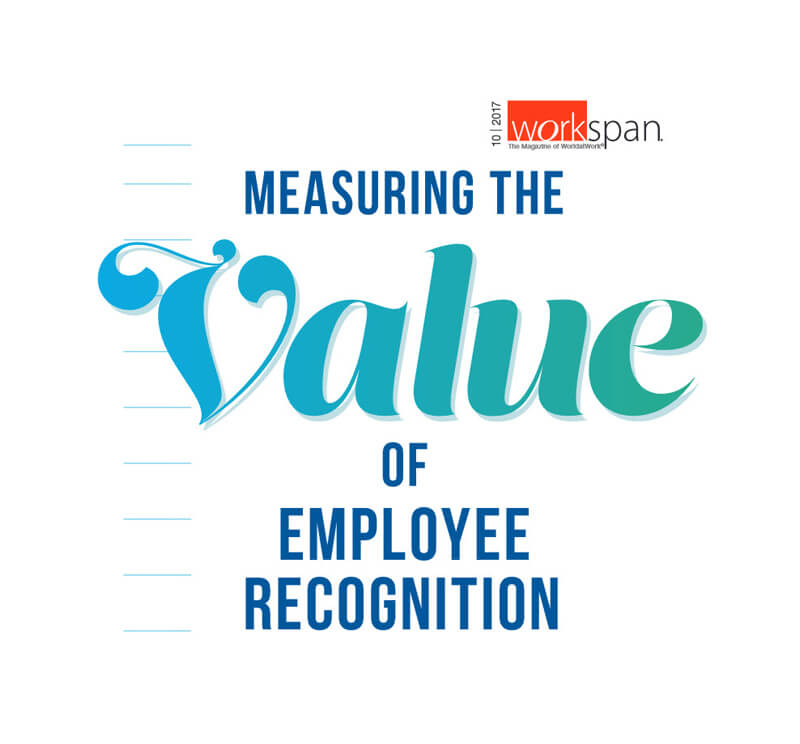Summary
With enterprise-level reward and recognition programs becoming commonplace, HR leaders can no longer afford to ignore the breadth of data and ROI analysis potential modern recognition platforms provide.
Employers with high-performing employee recognition schemes also are some of the most successful, profitable and productive enterprises in the world. Engaged employees produce better business outcomes than their disengaged counterparts across all industries and company sizes, in good or bad economic times, with few exceptions. In fact, according to Gallup’s “2017 State of the American Workplace,” highly engaged businesses realize a 17% increase in productivity and a 41% reduction in absenteeism.
Using data can improve your organization’s approach to recognizing performance.
The art of engaging employees, however, is a continuous challenge for organizations, even for those that seem to do it well. Gallup reports that a majority of the U.S. workforce (51%) isn’t engaged. Top reasons for dissatisfaction include a negative manager-employee relationship, an undesirable company culture, a disconnection from the company’s high-level goals and employees not receiving feedback or being recognized for their efforts.
Understandably, employee recognition programs have emerged as a chief strategy to help improve employee engagement, and are more popular than ever. According to a HALO Recognition survey of 100 HR professionals, 73% of respondents are interested in expanding recognition programs during the next year.
In the past, recognition programs were ad hoc and not much was known about how to effectively measure their effectiveness. However, thanks to the power of data-driven systems, key performance indicators (KPIs) of recognition programs can be identified, measured and clearly tied to business objectives, turning employee recognition from a nice-to-have fringe benefit to a tangible, actionable engagement strategy.
By harnessing the wealth of usage and feedback data available in recognition programs, HR leaders can derive great benefits. Employee recognition programs can be leveraged like a large-scale communications apparatus, and savvy employers use input data to fine-tune programs, giving their messaging the greatest reach. They create a companywide language of appreciation and recognition that accurately reflects their organizational character. This is only made possible by capturing and measuring data.
HR leaders have their own KPIs as well, such as turnover, productivity and employee satisfaction goals, at an overall organizational level or individually by department or location. Organizational goals can be interwoven with recognition measures, and new KPIs can be formulated to track intangibles such as engagement, happiness and morale.
51%
Gallup reports that a majority of the U.S. workforce (51%) isn’t engaged.
73%
of respondents are interested in expanding recognition programs during the next year.
While the very nature of intangibles makes them hard to pin down, this comes pretty close to creating a reliable ROI system for recognition efforts. Most important, it can be reported and shared, opening new and unexpected avenues of discussion on companywide engagement strategies. Here are some of the most popular ways recognition program data are leveraged.
Effect on Retention Rates
Effective employee recognition should yield a measurable drop in voluntary turnover rates.
Comparing general recognition program usage statistics — such as number of logins, frequency of recognition, rewards redemption and number of nominations — to departmental turnover can help pinpoint the most effective recognition methods. Examining these metrics can also help identify areas where extra emphasis on retention may be required. Add retention and turnover measurements to your regular reporting on the recognition program and note any correlations or outliers.
Influence on Productivity
Effective employee recognition should drive a measurable increase in productivity that improves overall performance.
Reviewing the progress and work productivity of each employee and setting concrete goals. For example, a sales increase by X percent per year, can help determine the recognition program’s influence on overall productivity. KPIs can be measured from a variety of populations — companywide, department or by location depending on what the organization is trying to influence or when it is trying to pinpoint best practices and areas for improvement.
Effective employee recognition should create positive feedback loops that yield increasingly better engagement the more they are used.
Each department/team must be judged by its own merits, because success criteria can vary greatly from one workplace to another and even from one workplace role to another. For example, productivity benchmarks for the finance and accounting team are much different than they are for sales or customer service. Comparing general recognition usage statistics to business unit performance can help reveal what motivates employees in individual areas and help sharpen your recognition ROI strategy.
Our health-care clients frequently use a “Moneyball” approach to great success. For example, one client set a goal in the radiology department of decreasing patient transport time to meet benchmarks. The client created a team initiative that allowed radiology transport staff to nominate each other for rewards when they did things to achieve the team’s goal. Nominations were compiled monthly with the top performers receiving a reward in the form of points, redeemable online for a variety of gifts.
Our health-care clients frequently use a “Moneyball” approach to great success. For example, one client set a goal in the radiology department of decreasing patient transport time to meet benchmarks. The client created a team initiative that allowed radiology transport staff to nominate each other for rewards when they did things to achieve the team’s goal. Nominations were compiled monthly with the top performers receiving a reward in the form of points, redeemable online for a variety of gifts.
Transport times were decreased beyond industry benchmarks, and afterward employees felt accomplished, not overworked. Adding a layer of personal accomplishment and tangible rewards to team goals can produce an observable boost to productivity.
Recognition Boosts Engagement
Effective employee recognition should create positive feedback loops that yield increasingly better engagement the more they are used.
Assessing the quality and variety of recognition offered at highly engaged locations as opposed to disengaged locations can help continually refresh programs to keep up with the engagement curve of the workforce. These KPI measurements can also reveal unique feedback about geographic or generational groups of employees including what kinds of programs are garnering the most activity.
Many industries, such as retail and hospitality, experience higher-than-average turnover, and rely heavily on recognition usage data by location to track the circumstances in which employees are being recognized and how often they log in to recognize each other. They also encourage healthy manager-employee relationships, a top driver of retention, by empowering managers with their own recognition tools. Recognition initiatives are typically drawn from company values. When companies see program usage rise, they have a solid metric to chart engagement with those values.
Manager involvement is always a wise engagement measurement as well. Managers provide the human face to your recognition efforts and give much-needed balance to formal rewards with informal ones, such as off-the-cuff praise in front of peers or buying breakfast. With a little open communication between management and the C-suite, ROI goals and KPIs can be formulated for informal recognition like any other data stream. Frontline managers also hold a wealth of anecdotal and informal data concerning morale, employee feedback and the workplace culture that can be regularly collected.
Factor In Your Uniqueness
Every organization will have unique people, culture and goals that should be factored into determining the best recognition KPI measurements.
With enterprise-level reward and recognition programs becoming commonplace, HR leaders can no longer afford to ignore the breadth of data and ROI analysis potential modern recognition platforms provide. Factors such as engagement, value and productivity can be measured in several places in several ways. Your unique framework for measurement is what ultimately matters.
A version of this article was previously published by Workspan











